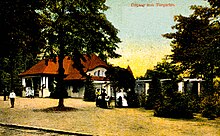Rostock Zoo
| Zoologischer Garten Rostock | |
|---|---|
 Entrance at Barnstorfer Ring | |
 | |
| 54°4′41.1″N 12°5′25.26″E / 54.078083°N 12.0903500°E | |
| Date opened | 4 January 1899 |
| Location | Rennbahnallee 21 18059 Rostock |
| Land area | 56 ha (140 acres) |
| No. of animals | 4500 (2012)[1] |
| No. of species | 320 (2012)[1] |
| Annual visitors | 637.000 (2013)[2] |
| Owner | Zoologischer Garten Rostock gGmbH |
| Website | www |
Rostock Zoo (German: Zoologische Garten Rostock) is a
History
From foundation to 1945

Around 1864, previous military grounds were transferred into a garden, and by 1866 completed and named Trotzenburg. In 1898, the first fenced animals were introduced, as wild boar and different kind of deer. The next year was the official opening for the Hirschgarten an der Trotzenburg, and the first zookeeper, Carl Lange, was employed to take care of the different animals.[3]
1945 to 1989

The air bombings during World War II on the city of Rostock were extremely heavy. All buildings and enclosures in Rostock Zoo were destroyed. In 1951, the garden architect, Arno Lehmann, started the renovation and rebuilding of the zoo. Many people from the town volunteered in this work, with direct manual work, as well as with their support. The zoo was re-opened for the public in 1952, was enlarged in 1956, and renamed and refounded 16 January 1956 as Zoologischen Garten Rostocks
In 1960, the two first Asian elephants arrived to the new built elephant enclosure, and later Rostock Zoo took over the breeding of Arabian horse and became the largest breeder of the horse in the entire East Germany. In 1963, the first polar bear was born in the zoo, and it was given the name Katja. In 1973, the zoo was once again enlarged with an added 56 Hectares, coordinated with a new master plan.
Since 1980, Rostock Zoo is
Since 1989

In 1992, Gemeinnützige GmbH Zoologischer Garten Rostock was founded and chaired by Rostock Zoo director, Udo Nagel, and from 1992 until 1998, several new animal enclosures were established, among them
In 1999, the zoo celebrated the Jubileum named 100 Jahre Tiergärtnerei, after being a garden for a hundred years.
The female African elephant, Sara, who was the oldest in a European zoo, died 2013, and ended the Zoo's keeping of elephants, and the elephant enclosure was replaced with Pygmy hippopotamus.
Darwineum

Named after the originator of the theory of biological evolution by natural selection, Charles Darwin, Darwineum was opened on 8 September 2012. This living museum, which covers 20,000 m2, and contains over 80 species of animals, was the largest building project throughout Rostock Zoo history, at a cost of more than 28 million Euro.
In two interactive expositions is biological
-
Polar bears in the Zoo
-
Meerkat in the Zoo
-
Antelope squirrel in Darwineum
References
- Much of the content of this article comes from the equivalent German-language Wikipedia article. Retrieved on 16 January 2014. Some of the following references are cited by that German-language article:
- ^ a b "Tierpark Rostock- Darwineum & Polarium | Rostocker Zoo Tiere".
- ^ "Presse Kontakt und Mitteilungen Zoo Rostock" (PDF).
- ^ Historie des Rostocker Zoos, retrieved 10 August 2012.
External links
- Official website

 Media related to Rostock Zoo at Wikimedia Commons
Media related to Rostock Zoo at Wikimedia Commons



